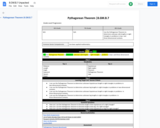
Use the Pythagorean Theorem to determine unknown side lengths in right triangles in problems in two- and three-dimensional contexts
- Subject:
- Mathematics
- Material Type:
- Activity/Lab
- Author:
- Liberty Public Schools
- Date Added:
- 04/13/2021

Use the Pythagorean Theorem to determine unknown side lengths in right triangles in problems in two- and three-dimensional contexts

This is a task from the Illustrative Mathematics website that is one part of a complete illustration of the standard to which it is aligned. Each task has at least one solution and some commentary that addresses important asects of the task and its potential use. Here are the first few lines of the commentary for this task: Find a way to partition a regular hexagon into 2 congruent figures. Explain how you know the 2 figures are congruent. Find many ways to partition a reg...

This is a task from the Illustrative Mathematics website that is one part of a complete illustration of the standard to which it is aligned. Each task has at least one solution and some commentary that addresses important asects of the task and its potential use. Here are the first few lines of the commentary for this task: The point in the $x$-$y$ plane with coordinates $(1000,2012)$ is reflected across the line $y=2000$. What are the coordinates of the reflected point?...
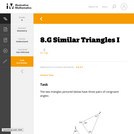
This is a task from the Illustrative Mathematics website that is one part of a complete illustration of the standard to which it is aligned. Each task has at least one solution and some commentary that addresses important aspects of the task and its potential use.
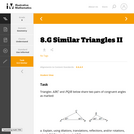
This is a task from the Illustrative Mathematics website that is one part of a complete illustration of the standard to which it is aligned. Each task has at least one solution and some commentary that addresses important aspects of the task and its potential use.
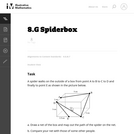
This is a task from the Illustrative Mathematics website that is one part of a complete illustration of the standard to which it is aligned. Each task has at least one solution and some commentary that addresses important asects of the task and its potential use. Here are the first few lines of the commentary for this task: A spider walks on the outside of a box from point A to B to C to D and finally to point E as shown in the picture below. Draw a net of the box and map ...

This is a task from the Illustrative Mathematics website that is one part of a complete illustration of the standard to which it is aligned. Each task has at least one solution and some commentary that addresses important asects of the task and its potential use. Here are the first few lines of the commentary for this task: Suppose $\ell$ and $m$ are parallel lines with $Q$ a point on $\ell$ and $P$ a point on $m$ as pictured below: Also labelled in the picture is the midp...
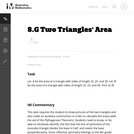
This is a task from the Illustrative Mathematics website that is one part of a complete illustration of the standard to which it is aligned. Each task has at least one solution and some commentary that addresses important asects of the task and its potential use. Here are the first few lines of the commentary for this task: Let $A$ be the area of a triangle with sides of length 25, 25, and 30. Let $B$ be the area of a triangle with sides of length 25, 25, and 40. Find $A/B...
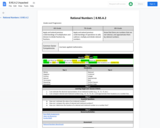
Estimate the value and compare the size of irrational numbers and approximate their locations on a number line.

This task is intended for instructional purposes so that students can become familiar and confident with using a calculator and understanding what it can and cannot do. This task gives an opportunity to work on the notion of place value (in parts (b) and (c)) and also to understand part of an argument for why the square root of two is not a rational number.
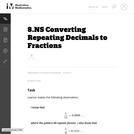
This is a task from the Illustrative Mathematics website that is one part of a complete illustration of the standard to which it is aligned. Each task has at least one solution and some commentary that addresses important asects of the task and its potential use. Here are the first few lines of the commentary for this task: Leanne makes the following observation: I know that \frac{1}{11} = 0.0909\ldots where the pattern 09 repeats forever. I also know that \frac{1}{9} = 0....
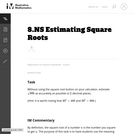
This is a task from the Illustrative Mathematics website that is one part of a complete illustration of the standard to which it is aligned. Each task has at least one solution and some commentary that addresses important asects of the task and its potential use. Here are the first few lines of the commentary for this task: Without using the square root button on your calculator, estimate $\sqrt{800}$ as accurately as possible to $2$ decimal places. (Hint: It is worth noti...
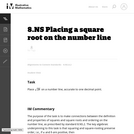
This is a task from the Illustrative Mathematics website that is one part of a complete illustration of the standard to which it is aligned. Each task has at least one solution and some commentary that addresses important asects of the task and its potential use. Here are the first few lines of the commentary for this task: Place $\sqrt{28}$ on a number line, accurate to one decimal point....

These lesson plans and activities were developed by Janine Darragh, Gina Petrie, and Stan Pichinevskiy and were previously located on the Reaching for English app. Created for K-12 English teachers in Nicaragua, the materials may be used and adapted for any country's specific context and needs.

This is a task from the Illustrative Mathematics website that is one part of a complete illustration of the standard to which it is aligned. Each task has at least one solution and some commentary that addresses important asects of the task and its potential use. Here are the first few lines of the commentary for this task: Is there an association between the weight of an animal’s body and the weight of the animal’s brain? 1. Make a scatterplot using the following data. Bo...

This is a task from the Illustrative Mathematics website that is one part of a complete illustration of the standard to which it is aligned. Each task has at least one solution and some commentary that addresses important asects of the task and its potential use. Here are the first few lines of the commentary for this task: Jerry forgot to plug in his laptop before he went to bed. He wants to take the laptop to his friend's house with a full battery. The pictures below sho...

This is a task from the Illustrative Mathematics website that is one part of a complete illustration of the standard to which it is aligned. Each task has at least one solution and some commentary that addresses important asects of the task and its potential use. Here are the first few lines of the commentary for this task: The scatter plot below shows the relationship between the number of airports in a state and the population of that state according to the 2010 Census. ...

powerpoint for second unit in cinema scenes film history book chapters 8 through 13

Lesson PlanDate: 1/16/18 Grade Level: 8Concept: Color Wheel Objectives:Students will demonstrate knowledge of color wheel in pairs by receiving 10/10 points on an assignment at the end of lesson.Introduction: Utilize prior knowledge of primary and secondary colors to incorporate new concepts of complementary colors. Motivational Device- Red dot on white board, introduction to complementary colorsVocabulary: Primary, secondary, complementary, cool and warm colors, and ROY G BIV.Body of Lesson: Ask student’s favorite color to transition into previous knowledge primary and secondary colors. Relate favorite colors or colors around the room to the color wheel and explain primary and secondary color relationships. Use red dot optical illusion to introduce complementary colors (motivational device). Introduce color wheel assignment (worksheet). Accommodations/Modifications: ADHD- Allow student(s) to stand or sit on exercise ball while working. Multiple Intelligence(s) Addressed: Linguistic- Provide alternate activity.Assessment: Color wheel assignment. Materials: Red paper, colored pencils, color wheel example, blank assessment Standards: HSE.MS.8.18- Understand Color Theory

Students will create an interactive Powerpoint game where they will create real world problems that are used as clues to move on to the next level. Problems include all 8th grade math standards.